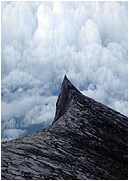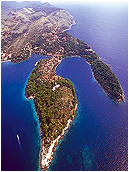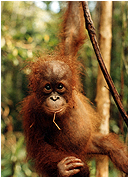Sabah | Sarawak | Brunei
Mount Kinabalu
 Mount Kinabalu towers 4095 meters (13,435 feet) above sea level. It is the highest mountain between the mighty snow-capped Himalayas and Wilhelmina (4509 meters / 14,793 feet) in Irian Jaya. It is also one of the most accessible and spectacular mountains in the world.
Mount Kinabalu towers 4095 meters (13,435 feet) above sea level. It is the highest mountain between the mighty snow-capped Himalayas and Wilhelmina (4509 meters / 14,793 feet) in Irian Jaya. It is also one of the most accessible and spectacular mountains in the world.
Because of the earth movement, in is still growing with the rate of 5 mm (1/4 inches) a year. Ever changing, it is the mountain of tropical rainforest, colorful blossoms and golden sunset, but also dark and violent storms. At times, a ghostly mist shrouds the mountain and it is easy to believe the local Kadazandusun's claim that it is the homeland of their spirit world.In 1964 Kinabalu Park was established to protect Mount Kinabalu and its plant and animal life. Its 754 square kilometer (291 square mile) terrain stretches upward from lowland rain forest to montane forest, cloud forest and sub alpine meadow, before finally reaching a crown of bare granite. Only at Mount Kinabalu can you eat breakfast in a lowland rainforest, lunch in a cloud forest, and enjoy dinner in a subalpine meadow!
The trail to the highest peak winds along the southern side of the mountain. It is an 8.5 kilometer (5.25 mile) trek to the top. For most people, from a 9 month-old baby (carried by father) to an 83 years-old New Zealander, the journey takes two days. The Kinabalu Park Headquarters is located 90 kilometers (56 miles) from Kota Kinabalu, Sabah's capital city. More than one million visitors have enjoyed the park since it opened. In the year 2000, UNESCO has declared Mount Kinabalu as The World Heritage Site.
Sipadan Island
 Island of Sipan is one of the islands of the Elaphite archipelago. Sipan is also the largest island of the archipelago covering area of 16.5 km2. There are two villages on Sipan - Sudurad and Sipanska Luka. Sudurad is located on the eastern side of the island, while Sipanska Luka is on the west. As Sipan is island that is in near vicinity of Dubrovnik (17 km away), this island is well connected with Dubrovnik and is very popular as tourist destination especially in the summer as there are regular boat connections to Sipan from Dubrovnik . The jouney takes about one hour. Sipanska Luka (Port of Sipan) is the main port at Sipan and is very popular destination for sailors being well protected harbour. There are numerous architectural monuments from the Middle Ages: the remains of Church of St. Peter on Velji Point from 11th century, Church of Sveti Ivan with its frescos from 11th and 15th century in Silova Sela, and the pre-Romantic Church of Sveti Mihovil from the 11th century, a Romantic-Gothic house, a Gothic tower, and the Renaissance Church of the Holy Spirit from 1569, all built as part of the Benedictine monastery in Pakljena.
Island of Sipan is one of the islands of the Elaphite archipelago. Sipan is also the largest island of the archipelago covering area of 16.5 km2. There are two villages on Sipan - Sudurad and Sipanska Luka. Sudurad is located on the eastern side of the island, while Sipanska Luka is on the west. As Sipan is island that is in near vicinity of Dubrovnik (17 km away), this island is well connected with Dubrovnik and is very popular as tourist destination especially in the summer as there are regular boat connections to Sipan from Dubrovnik . The jouney takes about one hour. Sipanska Luka (Port of Sipan) is the main port at Sipan and is very popular destination for sailors being well protected harbour. There are numerous architectural monuments from the Middle Ages: the remains of Church of St. Peter on Velji Point from 11th century, Church of Sveti Ivan with its frescos from 11th and 15th century in Silova Sela, and the pre-Romantic Church of Sveti Mihovil from the 11th century, a Romantic-Gothic house, a Gothic tower, and the Renaissance Church of the Holy Spirit from 1569, all built as part of the Benedictine monastery in Pakljena.
Back in 15th century, Sipan was popular place for Dubrovnik's upper classes to have their holiday homes built there. One of them, the Sorkocevic's family summer house stands out in particular. Also, in 15th century, a Gothic Rector's Palace was constructed above Sipanska Luka, bearing bifora on the facade. At Sipanska Luka, there is also Gothic Church of Sveti Stipan with a painting of Pantaleon. Beside this, the remains of Roman villas have been discovered in Sipanska Luka too, just to prove this place was populated long time ago.
Sepilok Orang Utan
 The Sepilok Orang Utan Rehabilitation Centre is a place where people can go to see orang-utans (Pongo pygmaeus) – the wild red apes of Borneo and Sumatra – in their natural habitat, the tropical rainforest. It is important to understand, however, that the purpose of the Centre is to train young orang-utans, which for one reason or another have been held in captivity, so that they may learn to live unaided in the forest. Viewed in a historical context, the story is more complicated and more interesting.
The Sepilok Orang Utan Rehabilitation Centre is a place where people can go to see orang-utans (Pongo pygmaeus) – the wild red apes of Borneo and Sumatra – in their natural habitat, the tropical rainforest. It is important to understand, however, that the purpose of the Centre is to train young orang-utans, which for one reason or another have been held in captivity, so that they may learn to live unaided in the forest. Viewed in a historical context, the story is more complicated and more interesting.
Sepilok is an old Forest Reserve, about 43 square kilometres in area, which before the introduction of heavy machinery was logged by hand for timber. In 1957, logging was banned and the Reserve was designated for research and conservation. When Sabah became an independent state in Malaysia in 1963, a Game Branch was created in the Forest Department for the conservation of wild animals. At that time, it was believed that the orang-utan was a very rare species, endangered with extinction. Up to that time, young orang-utan had been a popular pet amongst people in Sabah and elsewhere, and any young one caught during logging or forest clearance was in wide demand. With the new Game Branch came a new law which prohibited anyone from catching or keeping an orang-utan.
Many orang-utans which had been kept in captivity were confiscated – but something had to be done with them. Sepilok was chosen as the place where these orang-utans would be brought and trained to live a natural life in the forest. The rehabilitation process, as it became known, met and continues to meet varying degrees of success. Some orang-utans disappeared, some died, some grew to live a semi-natural existence… and some were successfully rehabilitated to survive unaided in the forest. Indeed, some have mated with wild orang-utans and produced babies.
One such baby – Juliana, born in 1976 – herself gave birth in Sepilok in 1987. Since the early days, it has become apparent that while orang-utans are rare, they are not endangered at present. It is now known that conservation of large areas of natural habitat is a surer way to conserve orang-utans than the rehabilitation programme at Sepilok. But orang-utans continue to come into Sepilok, nowadays not from captivity, but directly from areas where forest is being cleared for agriculture. Sepilok serves to give these unfortunate animals life in the forest rather than an uncertain future in a plantation. And, perhaps most importantly, Sepilok serves as a link between people and Sabah 's marvellous wildlife, where the young can gain their first insights into nature and the importance of caring for the natural environment.
An even rarer creature of the Borneo rainforests than the orang-utan can be seen at Sepilok – the Asian two-horned rhinoceros (Dicerorhinus sumatrensis), often known as the Sumatran rhino. This splendid animal was once widespread throughout South-east Asia . Indeed, during the first three decades of the development of Sandakan by the British Chartered Company, rhinos would often wander into the town and outlaying gardens. Early issues of the British North Borneo Herald mention visitors going off into the forests of the Sandakan hinterland to hunt rhinos, and there are advertisements giving the cost of rhino horn in local Chinese shops. Since those days, the Asian two-horned rhino has been reduced by excessive hunting as well as loss of forest to scattered remnants in Borneo, Sumatra and Peninsular Malaysia. A number of National Parks and Reserves have been established in all three regions in efforts to conserve the rhinoceros in the wild. Unfortunately, the horn of this rhino is worth more than its weight in gold in Chinese apothecaries, for it is believed by Asians of Chinese descent to be the most effective medicine to reduce fevers.